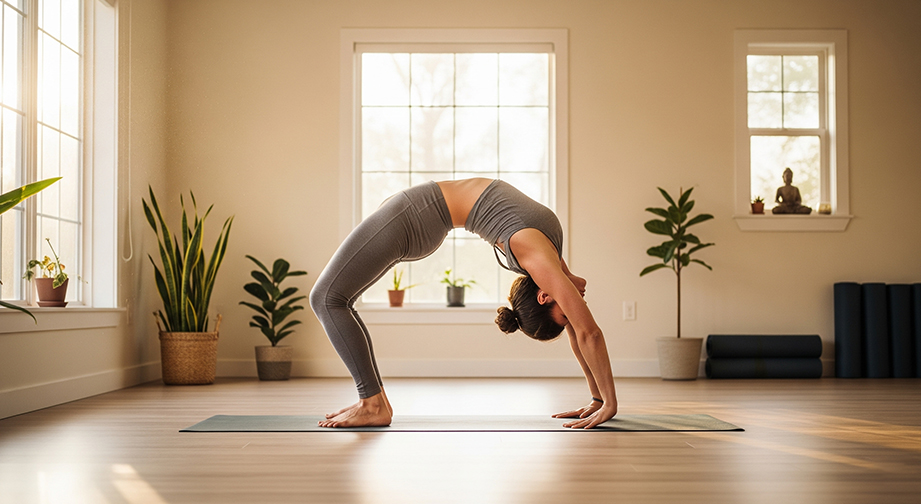Urdhva Mukha Shvanasana – Upward-Facing Dog Pose (Reclining): A Complete Guide
Introduction
If you’ve ever woken up with a stiff back or felt achy after hours at your desk, it’s time to meet Urdhva Mukha Shvanasana—the Upward-Facing Dog Pose. In Sanskrit, “Urdhva Mukha Shvanasana” means “upward facing dog position”. This yoga posture is all about energizing your body, opening your heart, and building strength.
Often featured in many yoga flows, Upward-Facing Dog is a rejuvenating stretch for the whole front body. It’s perfect for newcomers because you can feel the difference almost instantly—relief for tight hips, chest, and shoulders!
Stiff after sitting too long? Upward-Facing Dog might just become your new favorite stretch.
Step-by-Step Guide: How to Practice Upward-Facing Dog

- Start lying face down on your mat, legs straight behind you about hip-width apart. Rest the tops of your feet on the floor.
- Place your palms beside your lower ribs (not under your shoulders), fingers spread wide for support.
- Inhale deeply. Press firmly into your hands and tops of your feet, straightening your arms. Gently lift your chest, torso, thighs, and knees off the mat. Keep only your hands and the tops of your feet touching the floor.
- Open your heart: Roll your shoulders back and down, broaden your collarbones, and gaze forward or slightly upward (without crunching the back of your neck).
- Hold the position for 3–5 breaths (15–30 seconds), breathing slowly and evenly.
- Exhale to release: Lower your body back to the mat or transition into Downward-Facing Dog or Child’s Pose.
- Repeat: Practice 2–3 rounds, resting briefly between if needed.
Beginners: Modifications
- Keep thighs on the mat if lifting them is challenging.
- Bend elbows slightly or use a bolster under your hips for extra support.
Advanced Options
- Straighten your arms fully, press feet firmly, and lift thighs higher for more intensity.
- Incorporate leg lifts (alternate lifting a leg) for greater core engagement.
Alignment & Safety Tips
Key alignment cues:
- Spread fingers wide—press into the index finger and thumb pads.
- Wrists stay under elbows (not flaring out).
- Shoulders move away from ears (avoid “shrugging”).
- Keep hips anchored and thighs active.
- Look forward gently, lengthening the neck.
Common mistakes (& how to avoid):
- Collapsing lower back—engage core and lengthen spine.
- Splaying elbows—keep them pointing back, not out.
- Straining the neck—look forward, not up too far.
Safety precautions:
- Avoid if pregnant, or with carpal tunnel, back, wrist injuries, or recent abdominal surgery.
- Move gently if you have lower back issues—don’t push into pain.
Benefits of Urdhva Mukha Shvanasana
Physical Benefits
- Strengthens arms, wrists, and spine
- Opens chest and shoulders, improving posture
- Stretches abdomen, hip flexors, and ankles
- Invigorates the entire body
Mental Benefits
- Reduces stress and fatigue
- Boosts mood & confidence
- Encourages mindful breathing
Energy / Chakra Connection
- Opens the heart chakra (Anahata), promoting feelings of openness and compassion
- Stimulates solar plexus chakra (Manipura) for inner power and courage
Contraindications
- Pregnant women
- Recent abdominal, back, or wrist surgeries or injuries
- Severe carpal tunnel syndrome
Alternatives:
Beginner’s Tips & Variations
Props
- Block: Under hands for more height or support
- Bolster: Under thighs or hips for gentler backbend
Gentle Variations
- Keep thighs and hips on the floor (like Cobra Pose)
- Practice with arms bent if straightening is difficult
Advanced Variations
- Lifting one leg at a time (“three-legged up dog”)
- Flowing dynamically between Upward- and Downward-Facing Dog
How to Include in a Yoga Flow
- Best used as a warm-up or dynamic transition pose (often after Chaturanga, before Downward Dog)
- Pairs beautifully with:
- Chaturanga Dandasana (Four-Limbed Staff Pose)
- Adho Mukha Shvanasana (Downward-Facing Dog)
- Balasana (Child’s Pose)
Mind-Body Connection
As you breathe in Urdhva Mukha Shvanasana, imagine your heart lifting and opening—both physically and emotionally. Noticing sensations in your chest and belly helps you practice mindfulness. This position energizes your entire being, supporting feelings of strength and positivity.
On a deeper level, Upward-Facing Dog is connected to the heart chakra, inviting compassion and courage into your practice.
Summary Box
- Asana Name: Upward-Facing Dog Pose (Urdhva Mukha Shvanasana)
- Level: Beginner
- Focus Areas: Spine, arms, chest, shoulders, core
- Duration: 15–30 seconds, 2–3 rounds
- Best Time to Practice: Morning (or whenever you need a burst of energy!)
Frequently Asked Questions
- Is Upward-Facing Dog safe for beginners?
- Yes! Start with modified versions (like Cobra) if needed, and listen to your body.
- How is Upward-Facing Dog different from Cobra Pose?
- Upward-Facing Dog involves straighter arms and the thighs lifted off the mat, while Cobra Pose keeps hips and legs grounded and arms slightly bent.
- When should I avoid practicing Urdhva Mukha Shvanasana?
- If you have back, wrist, or abdominal injuries, or are pregnant, skip this pose or consult your yoga teacher first.